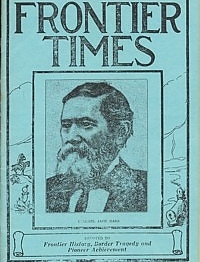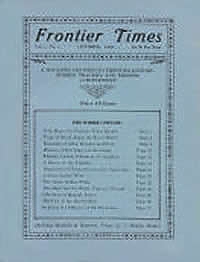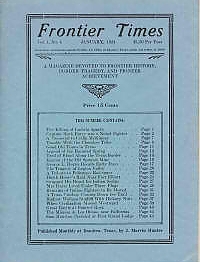By using our website, you agree to the use of cookies as described in our Cookie Policy
Magazines & Instant Downloads
Vol 08 No. 04 - January 1931
Jack Hays, Premier Texas Ranger
JACK HAYS WAS born February 23, 1817, on a farm in Wilson county, Tennessee, about twelve miles east of the Hermitage, the home of Andrew Jackson he was given such educational opportunities as the county then afforded, and when he was fifteen years old he went to Mississippi and secured employment with some surveyors. He received good training in this profession, and when he was twenty years old he came to Texas, and engaged in, this kind of employment. After a time be enlisted in the newly organized Texas ranger force, where his splendid qualities as a daring fighter and scout soon attracted public attention. In time he became captain of the Texas Rangers and was assigned to duty in Southwest Texas, patrolling the region of the Nueces to Corpus Christi. One of his notable exploits was the pursuit of about two hundred Comanche Indians, who had raided the country and stolen a great many. horses. With only twenty men he drove the Indians off and recovered the stolen stock. His defeat of the Mexicans at Laredo in 1841 and the services performed during the Vasquez and Woll raids upon San Antonio in 1842 are familiar to the reader of Texas history. This article goes on to recount other notable events and accomplishments in the great Ranger’s life.
Further Mentions: Lieut. Col. P. H. Relf,, In 1849, the California gold rush, Vicente Peralto, Samuel J. Tilden,
Drunken Bully Started Newton's "General Massacre"
Paul Wellman. The, in the early '1870's, was as notorious as ever were Dodge City, Abilene, Hays or Caldwell. This story is a brief history of Newton when it was a cow-town, between the years of 1870. and 1873. The famous "General Massacre" which awoke the citizens to a determination to bring law to their city, a determination which they carried out after a deadly struggle lasting for months. This is the story of the climax of that struggle.
Further Mentions: Dr. T, S. Floyd., Judge R. W. Muse, one of the city's first residents, Mr. Peter, Boot-foot Hill 'Which once was populous with graves of those, who died violently. Snyder and Welsh, Gregory's saloon, the Chisholm Trail. a mysterious character known as Irvin, Johnson, later city marshal of Newton, Lee, a handsome, friendly young cowpuncher, Emerson Hough, Frederic Remington, McCloskey, Riley, a gaggling, sunken-chested youth, in the last stages of consumption, Jim and Richard Anderson, Perry Tuttle, George Halliday, Fitzpatrick, Jim Shay, a desperado, Dave Hamil,
Pioneer Mother Tells of Early Days
Speaks of Sullivan family, early pioneers on Kansas frontier. Coming to Kansas as a bride was little short of adventure to the young Mrs. Sullivan who was then not yet twenty years of age. All her life she had spent in eastern Canada near Ottawa, and her coming west was the turning point in her life and that of her husband.
Further Mentions: Arthur Sullivan, Sullivan's dam, Arch McVickars and the Gibbons,
The Rider of Loma Escondida
J. Frank Dobie. Captain Crouch's foreman Otis Coggins, while riding near Loma Escondida, sees a mysterious stranger riding into a mesquite tree, and back out agian! His investigations lead to a discovery that…
Further Mentions: Captain Crouch, a veteran of cow camps, Loma Escondida. Presidio Crossing on the Leona River, Jeff Cassidy, the 7D's, the old L7 ranch, Sheriff Rhodes, Friotown, Newton boys, Alfredo, Trebe's commissary, the Trebes ranch, Otis Coggins, the Crouch ranch,
Texas Rangers May Lose Even Their Name
Will the glorious frontier force of Texas be blended into a massive state agency? Such was the SUGGESTION which has been made by Capt. Tom Hickman of the Texas state rangers Article goes on to describe early days of the Rangers and formative events.
Further Mentions: It was in 1874 that the first financial provision was made by the legislature for the maintenance of a ranger force. John B. Jones of Corsicana, H. M. Bundy, Capt. J. B. Gillett, Lipans and Kickapoos, Comanches and Kiowas, Apaches, Capt. John Ikerd, Lieut. Millican of Ikerd's company, Capt. H. J. Richard, Fort Duncan, Dr. Woolbridge, Corp. Eckhart, David Adams, Eagle Pass road, the Blance, 16 miles east of Fort Inge, Walter Richarz and Joseph Riff., Capt. McNelly
The Adventures of Big-Foot Wallace
By John C. Duval. First Published in 1870 (Continued from last month). This installment brings Big-Foot to the ill-fated Mier Expedition. Great step-by-step account with the great hero into the hell-hole of Mexico and this terrible moment.
Further Mentions: Tonkawa warriors, Tom Jones, Bill Decker, Jeff Bonds, Big-Foot's ranch., Brigadier-General Somerville, De Boyce, Colonel Bennett, General Green, Colonel Cook, Colonel Fisher, Tom Hancock, Captain Sameron, Dr. Sennickson, Mexican officers, Algereto and Carasco. General Ampudia,
Bexar
By Frederick C. Chabot, San Antonio, Texas. The great city of San Antonio originally had the name of "Bexar" . This story recounts the most early events surrounding the founding and emergence of San Antonio and many excellent details are offered.
Further Mentions: the site of modern Bexar or Bejar, situated about twenty miles south of Madrid, Spain., Juana was the second wife of Herman Cortesy Mouroy, the famous conqueror of Mexico, the Marquis of the Valley of Oaxaca. In 1604 Cervantes Saavedra dedicated his Don Quixote to another duke of Bexar. the Olivares Espinosa-Aguirre Expedition who named the San Pedro Spring., Rio de San Antonio de Padua, Father Olivares San Antonio de Padua, the Raman Expedition (1716), In the early part of 1718 Alarcon arrived with his expedition, San Antonio de los Llanos, General Teran, Kendall County was created January 10, 1862, and was organized February 18th, of the same year. Its county seat was Boerne. It was named after George Wilkins Rendall, a native of New Hampshire, who in the early 30's established himself in New Orleans, and was instrumental in founding the Picayune at the place. His participation in the Santa Fe Expedition is universally known. Subsequent to his marriage with Adeline de Valcourt, he removed to New Braunfels, Texas, and in 1875 acquired his first great tract of land in, what is now Kendall County. Comal County was created March 24, 1846; Guadalupe, March 30, 1846; Medina, February 12, 1848; Atarcosa and Bandera, January 24th, 1856; and Wilson County was created from territory formerly included in Bexar, February 13th, 1860. The old county was gradually reduced to the present county of Bexar, hounded by Kendall, Comal, Guadalupe, Wilson, Atascosa, Medina and Bandera counties.
Nueces Valley History Told by Mathis Woman
San Antonio Express. Story of, who lived sixty years in the Nueces Valley, and wrote a book about it. This account describes the book and the woman who wrote it. Further Mentions: the bride of S. G. Miller, Terry's Texas Rangers. Mrs. Calile Freeman.Old Broad, King of Longhorns, Coming Back Houston Chronicle. Story of the Longhorn breed of cattle, especially of a giant Longhorn Steer, Old Broad, whose magnificent horns, reached 8 feet and 2 inches from tip to tip. Further Mentions: Frank Dew, well known Houston cattleman, who raised him, Another steer "Villa" now rules where Old Broad once was king. Lee Russell, of Fort Worth,
The Autograph Library
"The one and only very original Autograph, Library at Christmas Cove, founded, developed and maintained entirely by, the Poet Ranchman of Texas, is a great addition to Christmas Cove and thereabouts. Many autographed copies are included in the library. Numerous names are mentioned in story. "Mr. Chittenden was born in Montclair, though, he has long been interested in Jones County, Texas, where he still has a large ranch of many thousand acres and a very flourishing colony of 45 families, all interested in farming, cattle and…"
Veteran Officer Tells of Wild Days
Lawman speaks of wild days in and around. An excerpt: ""We lived the first winter in Waco and the following spring moved to a town. Good black land was worth $2 an acre. But because a plow would not scour in black land, as plows did in the soil of Tennessee, father concluded it could not be very fertile, and he selected for his purchase a tract of sandy land. Up to that time there was very little land in cultivation, though farmers were coming now in droves. The open country was full of cattle and horses, all pretty wild, and in almost any direction you could see a bunch of deer, not much wilder than the cattle and horses.
Under the reconstruction, period, the lawlessness of war times bad been continued in, Texas. Thieves were so numerous and bold that it was not safe to turn a work horse out at night. The thieves found a secure retreat in the bottoms of the Brazos River. But all this very speedily changed when the Hon. Richard Coke of Waco beat Governor Davis, the reconstruction, Governor, for re-election, and the people of McLennan County at the same time made Gen. Sul Ross Sheriff.
Further Mentions: Paris, Clarksville, McKinney, The Houston & Texas Central Railroad, Ellis County, Waco, The Waco Tap Railroad, a spur *of the Houston & Texas Central, from Bremond to Waco, Lampasas and Brownwood, both wild towns, Coryell. Hamilton and Brown Counties, Constable Joe Ellison, Brann's Iconoclast, the day the Harris brothers were killed by Judge G. B, Gerald, Lon Moore and his brother, who had killed Abe Pate, Deputy Sheriff of Dallas County. Sheriff Ben Cabell., 'Deputy Sheriff Pate, Allison Harrison,
Woman Who Fought Savages Smiles at Troubles
San Antonio Express. Story of brave, who when she was just 14 did the family laundry in a creek and at one time was attacked by Indians while gathering it. She was forced to battle hand to hand with a savage to defend her baby brother at the same time.
"It was about sundown," she said "when my three little brothers, a visiting boy, Lon White, and I went down to the creek, which flowed about 100 yards from our home. I being the older, and a girl, was delegated to take the laundry from the bushes on which I had hung it earlier in the day. I reached resignedly for the first piece but never touched it for as I turned I saw an Indian hiding in the thick bushes with his rifle trained directly on me. I screamed to my companions to run and at the same time heard the detonation of the gun and felt the impact of the bullet.
"The Indian ran, toward me as he fired and seized my hair as if to scalp me. A net I wore came off in his fingers and, evidently at a loss, he threw me down on the ground and caught up my little brother, George. George was, standing near me and I grabbed him at the same time. The Indian tried to jerk him away but I held on with what little strength I had left. - I hesitate to think what might have happened then had not the family pet ' - a huge bulldog, come up snarling and engaged the Indian from the rear. His arrival and that of my mother with a rifle clutched in determined hands caused a rather precipitate retreat; not, however, before they had fired a, parting shot at me which struck me just above the left elbow...
Further Mentions: a farm about 10 miles from Jacksboro on Keechi Creek, where the attack occurred, Lon White, Jim Kelton; Upshur county, J. C. Cox, Decatur, Gen. Jim Throckmorton,
Bowie and the Bowie Knife
J. Frank Dobie (an authority on the Bowie knife) Offers little known background and info on both the famous Texas hero and martyr, and the legendary Bowie knife.
Further Mentions: James Bowie was born in Georgia, but in the year 1802 removed to Catahoula parish, Louisiana. The two brothers, James and Resin, came into the state of Mississippi… a young man by the name of Lattimore, a son of Dr. William Lattimore, Sturdevant, Judge Crane, he became a naturalized citizen at Saltillo, and soon after married the daughter of vice-governor Veramendi, of San Antonio. On the 2of November, 1831, James and Rezin Bowie and seven other Americans and two negro servants, started from San Antonio to hunt for the San Saba silver mines. the surrender of Piedras, at Nacogdoches, Bowie was superior to Fannin, who was then only a captain, while Bowie was a colonel. Bowie was for a time connected with the army at Goliad. Lieut. Gov. Robinson, Gov. Smith.
Texan Saw "Stars Fall"
By Mike Pinehart
"I was about 15 years old, then," She said. "We lived in Shelby County, three miles from a neighbor. We were eating supper, when suddenly I decided to go out on the front porch and get a drink of water. When I opened the door, I was startled by streaks of fire flying in every direction. It looked like millions of stars were shooting down to the ground, Several yards from the side of the house, we had a hog pen, and it seemed like most of the stars were falling right in on top of our hogs.
"I screamed to father. The whole family came rushing out. For a moment, father gazed at the scene of falling fire. I could see his face as the flashes lit up everything, and it had a look I shall never forget.
'Children,' he said, 'the world is coming to an end. We had better…
Further Mentions: Mrs. Roberts, who before her marriage was Julia Palmer, born in Shelby County in 1820, While still in her teens, the family moved to Leon County, near Jewett, Mrs. Mattie Vickery,
Groesbeck, in Limestone County. she was married to William Roberts. Hogg and Clark campaign. Persotiville to Farrar
Woman Describes Pioneer Days in Falls County
By Marjorie Rogers, Marlin, Texas. Account of the early 1850's by. Mrs.. Maxwell lived in Falls County 77 years and watched it grow from a wilderness. She left the county only twice on short visits. She is the mother of six children:. This is great early history and genealogical info of the region.
Further Mentions: Sarah Melvina Greer, daughter of John Greer, was born in Sevier County, Arkansas, September 11, 1846, where she lived until 1852 when she traveled with her family to Texas in quest of her mother's health. On this trip the family camped for two weeks at Waco.
"There was only one log store that is now known as the city of Waco. The proprietor lived in one end of the long building and kept store in, the other. Travelers usually camped here because it was the best place to cross the river. There were no bridges then and folk had to wait if the river was on a rise until the rise fell.
Further Mentions: On November 8, 1853, we pitched, camp in Falls County, on: Pond Creek, near the present town-cite of Travis, Johnson Poole, the well known Indian fighter, and his family, were our nearest neighbors. They lived six miles from us. the H. and T. C. Railroad., Marlin, the present county , seat of Falls County, was just a crossroads village when we stopped in '53 to buy axes from Green & Bartlett, Boles & Co. in '56. The latter store was the first brick building to be erected in Marlin, and now is used as the city ball. The first courthouse was built by Francis Fredro, Robert E. B. Baylor was the first judge to hold district court on April 21, 1851. the first Baptist Educational Society. J. B. Wright was the first preacher of the first church organized in Falls County. This was a non-denominational church located at Salt Branch. The Marlin Baptist Church was organized April 10, 1852, by Elder Z. N. Morrell, a pioneer missionary Baptist preacher from Tennessee. Z. N. Morrell came to Texas in quest of health, and did much toward organizing churches and spreading the gospel over the wilds of Texas. The original members of the Marlin church were A. B. Ewing, L. S. Barton, Nacy Dobbs, Margay Morgan, a Mr. and Mrs. Prewitt and their one servant. "The first Presbyterian church, located about two miles east of the present town of Durango at a place known at that time as Carolina, was organized by John Balsch November 12, 1853. Coleman Prairies, J. W. Jarvis, teacher. Viesea, Sumpter Reed, the Jones farm, B. A. Shepherd, Uncle Amos Foster, Cedar Springs, the Milani district, the old Tankoway Indian village, the home of Col. Zenas Bartlett, who served Falls County as treasurer during the civil war. Isaac Marlin, son of John Marlin, pioneer settler, for whom the town of Marlin is named, Colonel Barlett built a residence upon this town tract of land, and today it is occupied by Mrs. Mollie Bartlett, daughter-in-law of Colonel Bartlett. This is the oldest habitation in Falls County."
LOST WILD. STALLION ON TEXAS RANGES SUBDUED BY LASSO
The king of the stallions, the last of the wild horses in Western Texas, has a rope around his neck for the first time in his fifteen years of life. The giant bay; the only animal in 120-section pasture of J. H. Tippet in Culberson county, at the foot of El Capitan mountain, the highest peak in Texas, gave up after five cowboys had trailed him in relays for three days and nights. Riding day and night, the cowboys finally got him…
TEXAS PIONEER IMPRESSED BY STATE IN 1836
Photostatic copies of a letter writ. ten May 18,, 1836, by from San Augustine to his brother in Connecticut have been acquired by the University of Texas library. The original is in the hands of descendants of the brother to whom it was written. Descendants of S. Allen now live in Georgetown and Cameron
The first part of the letter tells of the possibilities of Texas as a place f or a man seeking his fortunes here. His description of the Battle of San Jacinto is graphic and he concludes with this comment: "The only reason that quarter was given to any was because our men were satiated and. glutted with human blood." The full significance, of the battle had not come to his knowledge, for he thought the only possibility for Texas was independence with hopes of annexation to the United States. Santa Anna should, by all means, be put to death by legal process, he declared. "The tyrant is now in our power," he said, "he richly deserves death, and we ought to inflict it on him to avenge the brave and gallant spirits who have been inhumanly murdered by his order."
According to the letter, Allen, was staking all his possessions on Texas land. He offered his brother all the land he could use if be decided to come to Texas, saying that he himself had all lie could possibly-use and planned to double his property in the next year….His letter is invaluable, according to Miss Winnie Allen, assistant archivist in the library, as an indication of the public spirit at the time it was written. It shows a very wide knowledge of affairs and conditions in Texas.
A PIONEER EDUCATIONAL INSTITUTION
One of the early and most noted educational institutions ofNortheast Texas was, Red River county. This institution of learning was founded by Rev. John Witherspoon McKenzie, in 1841.
The founder and only owner of the school was born in North Carolina in 1806 and was educated at the University of Georgia. Early in life Mr. MeKenzie became a member of the Methodist church and was licensed to preach. In 1836 he was sent as a missionary to the Indians in what was then, the Indian Territory. Three years later he accepted a large circuit from a Conference in Northeast Texas. His health failing so that he was unable to continue his work as a circuit rider, he settled on a farm near Clarksville. He soon opened his first school, which was housed in a log cabin and attended by sixteen pupils. The school was continued for twenty-five years, buildings being added as needed, and the enrollment finally reached 405. Students came from all. sections of Texas and from Arkansas, Louisana and the Indian Territory.
Like many Southern institutions, McKenzie Institute was…
$4.95
‹ Back








